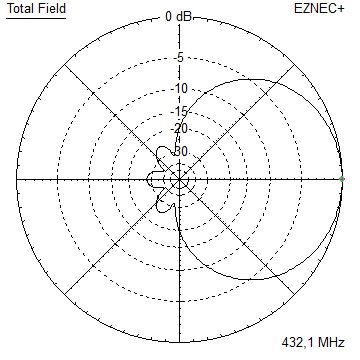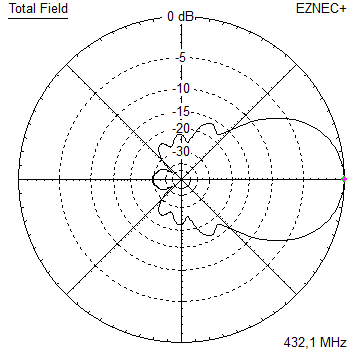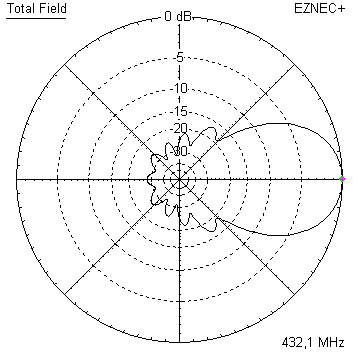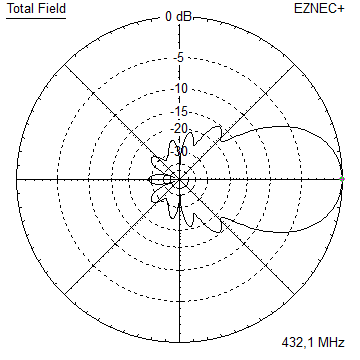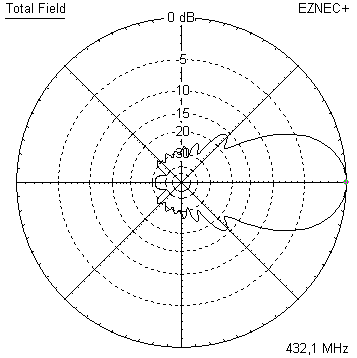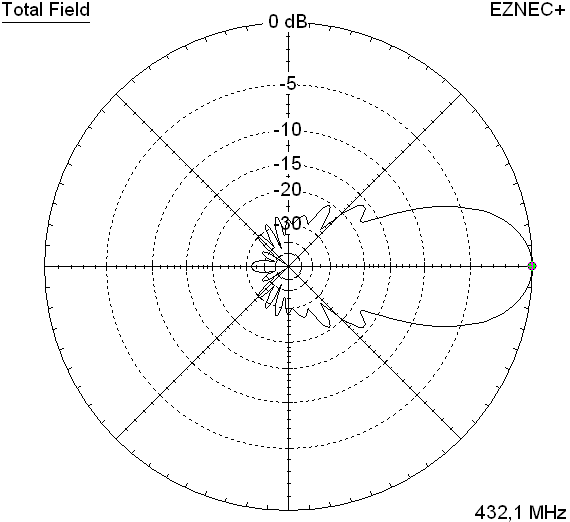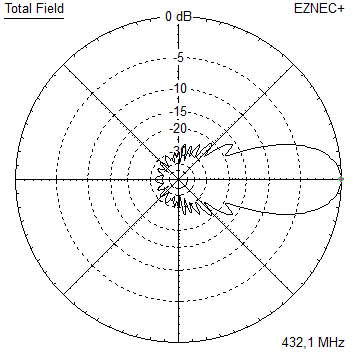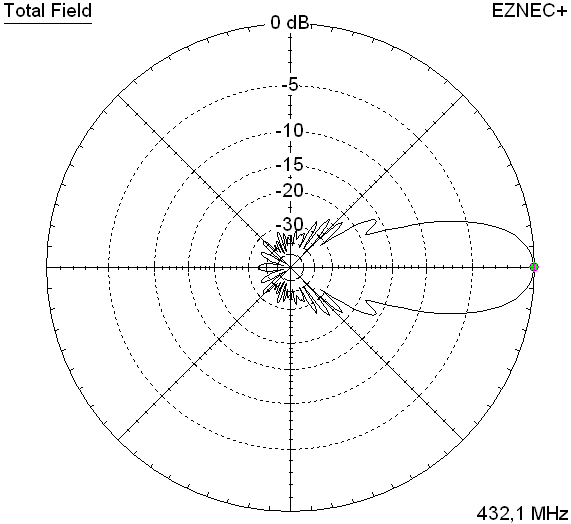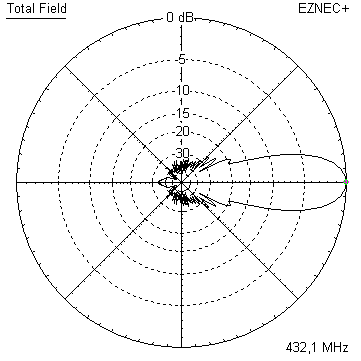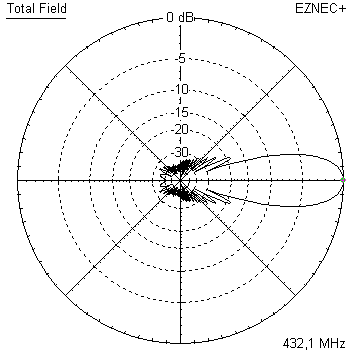
GTV 70-4m Yagi with bent Driven Element
EME + SSB band, with some loss usable up to 440 MHz, clean rear pattern version
This little Yagi has a high F/B, which makes it quite useful as a contest stack.
The bent DE (K6STI style) transforms from approx. 17 ohms to 50 ohms at feed point.
GTV 70-4m with nicely make Blade Dipole, EME approved by M0ABA at MX0CNS

QRPP EME with GTV 70-4m on wooden lace and with pulled out D2!
During the ARRL 2017 EME Contests 2nd leg W5RZ and NC1I did nice QRPP QSOs which demonstrates
how unaffected the GTV takes changes ... this might encourage you to build one even if it is far
from perfect by mechanics or geometry


good and Frank said my best was -26 (dB). That caused thinking, which can be dangerous!
I went out and removed the front director from the antenna, making it a 3 element yagi. About
an hour later I called NC1I with the 3 element antenna, and even though signals were weak,
we were able to make a QSO!"
Station at W5RZ: FT-817, RF Concepts PA, abt. 60 watts,
NC1I uses a 48 x 15 ele. K1FO (31.5 dBi) fully polarisation rotatable array, see here
Thanks and congratulations to Dennis & Frank!
Read more on MX0CNS Facebook
QRPP EME with 500 W EIRP
 Link to OK2KKW website reporting on the achievements with that Yagi
Link to OK2KKW website reporting on the achievements with that Yagi + + + on 2016-02-13 20:40 UTC : MX0CNS/M0ABA using this tiny antenna established an EME QSO with DL7APV + + +
• GTV 70-4m built by Thomas, M0ABA


And the QSO in WSJT (screenshot MX0CNS) running 80 W out - 1.2 dB feedline loss + 9.2 dBi from the Yagi = 504 W EIRP only.
Mind that the 13th of Febr. provided challenging EME conditions. Faraday Rotation in plenty and rain ie. wet antennas on both sides.

Take a look at photos explaining how to build this Yagi below
Yet another nice built by Kazuo, 7L1TIG. The bent dipole is made from 10 x 2 mm sheet metal



Kazou made a whole set of websites about small DG7YBN Yagis, all redesigned in MMANA for 430-431 MHz.
A very clear and methodic work. I recommend this to read. Use a free website online translator.
'Sticks and wire' GTV 70-4m built by Dennis, W5RZ

A ferrite core placed at the feed should improve things, but it works.
Current Distribution & 3D pattern


This website has been viewed by how many 70 cm enthusiasts since Jan. 2016?
Performance Data
Elem. 4 mm
Gain vs. isotr. Rad. 9.2 dBi
Gain vs. Dipole 7.1 dBD
-3 dB E-plane 58.4 deg.
-3 dB H-plane 86.2 deg.
F/B -22.0 dB
F/R -20.8 dB
Impedance 50 ohms
Mechan. Length 337 mm
Electr. Length 0.49 λ
Geometry
The 4 mm elements are ment for an 'elements through boom' built.
Segmentation BC and Base BC (see BC page) must be added.
A simple symmetrising member may be made from a 3 x 1/4 Lambda line grounded at the far side with
N-flange-bushing and an aluminium plate and ferrite added as close as possible to the DE, see below.

Pos. Full Length 1/2 Length
in NEC
Refl. 0.0 331.0 165.5
DE(b) 73.0 310.0 33.5-155.0
DE(a) 105.0 67.0 0-33.5
D1 185.5 307.0 153.5
D2 337.0 284.0 142.0
ele. 4 mm ele. 4 mm
The Drivers diameter is 10 mm for all examples.
Use EZNEC's Auto-Segmentation at 1050 MHz.
For the SBC the frequency impact is 434.6 MHz - 432.2 MHz = 2.4 MHz
Multiplication with the 70 cm correction factor of 0.92 mm/MHz results in 2.2 mm to add to the common BC.
Using the proposed through boom insulators add a fixed offset on to BC of 0.7 mm so that total SBC = 2.9 mm
• "Ready to saw and drill" data for mounting 4.0 mm elements insulated through boom with SM5BSZ's BC.exe applied
Note that with an elements insulated through boom built for best results boomlength and positions to first /last element must be kept as given.
Because the position of an element relative to its nearer boom end is a serious parameter in the BC.exe.
This table is only valid for:
Boom shape: square
Boom dim: 5/8 x 5/8 in (15.9 mm)
Wall thickn.: 1.6 mm
Holes in boom: 6.0 mm
Offset rear: 300 mm
Offset front: 40 mm
• Data set for 4 mm elements with rear boom end offset = 300 mm for formast mounting

This table is only valid for:
Boom shape: square
Boom dim: 20 x 20 mm
Wall thickn.: 2.0 mm
Holes in boom: 6.0 mm
Offset rear: 300 mm
Offset front: 40 mm
• Data set for 4 mm elements with rear boom end offset = 300 mm for formast mounting

Sketch of Bent Dipole

Pattern and VSWR Plots
Elevation and Azimuth plot at 432.1 MHz
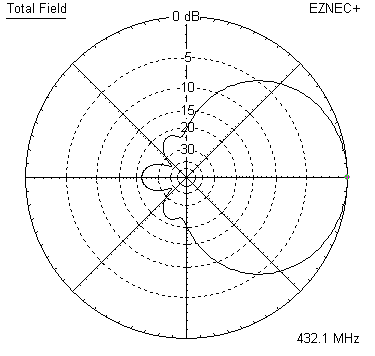
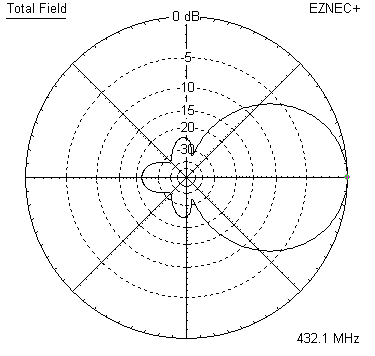
RL and SWR plot

Building one
The shown building style uses thin elements mounted electrically insulated through the boom. For this
the advanced BC.exe Boom Correction produced by SM5BSZ is applied. Feeding the dipole is a very simple and
lean construction shown here by M0ABA. It does not need a connection box and the only slightly difficult to make
part is the dipole center insulator. All in all building this way yields as cost effective as low weight and wind
load as can be, but electrically and mechanically very capable antennas.
• The making of a lightweight UHF Yagi
Insulators for mounting thin elements through the boom: Furniture hole plugs, with a self drilled hole Ø 4.0 mm


and later secured in position with a small screw or bolt; note the hole in the boom to place the bolt in

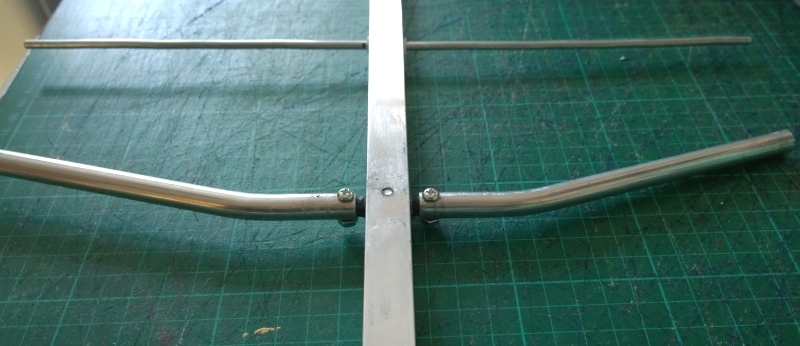


• How to make the Quarterwave Symmetrising lines grounded end:
On Left: raw material, a 30 x 30 mm square tube / on the right: the ready made and mounted bracket and bushing
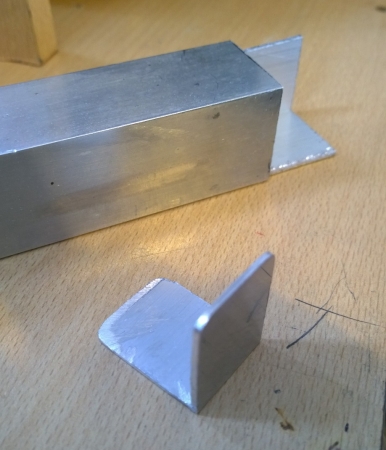



• Sealing the ends of the Quarterwave line with hot melt glue

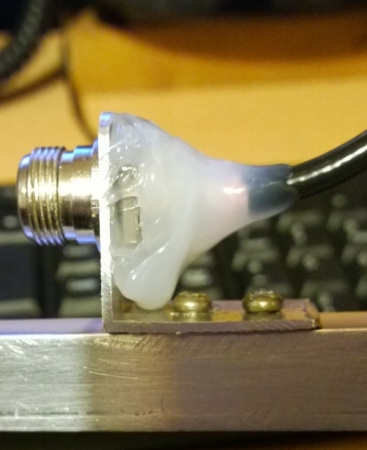
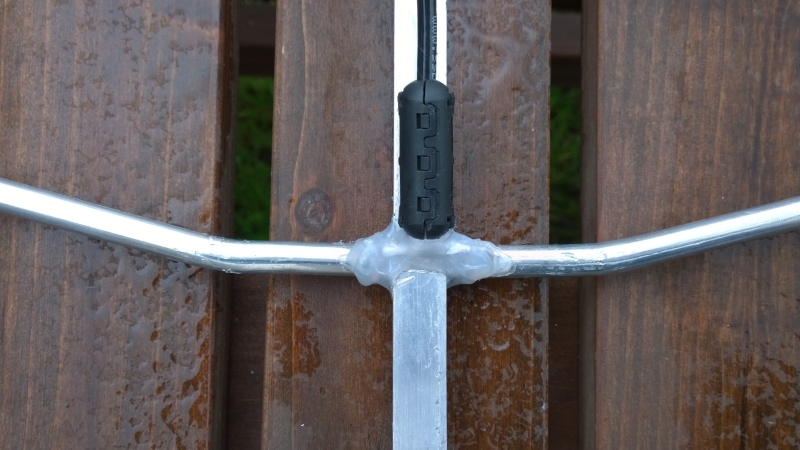
All photos in this chapter are on courtesy of Thomas, M0ABA
Downloads
EZNEC file of this Yagi with Ø 4 mm elements
Stacking
• For Yagis of a length less approximately 2 wL the DL6WU formula does not deliver best performance.
Hence the stacking distances for the GTV 70-4m are 'handmade', optimised using NEC.
• For very small Yagis the optimum stacking distances are that low, that mutual coupling between
the individual Yagis becomes a serious effect. Which spoils the VSWR. So that either an adaption of the Yagis
must take place or we just live with less Return Loss if practicable.
Elevation plot and data of 2 x vertical stack of GTV70-4m Yagis at 500 mm
Yaigs not modified. VSWR < 1.2 for 430 - 437 MHz and < 1.4 at 440 MHz

Stacking Dist. - NEC optimised small Yagi distance - H-plane 0.-- m E-plane 0.500 m
Elevation plot and data of 4 x vertical stack of GTV 70-4m Yagis at 500 mm each

Stacking Dist. - NEC optimised small Yagi distance - H-plane 0.-- m E-plane 0.500 m
Elevation plot and data of 8 x vertical stack of GTV 70-4m Yagis at 500 mm each


Symmetrising 50 to 50 ohms Feedline to 432 MHz Bent DE
The principle is similar to the 1/4 Lambda coax. Adding 2 x 1/4 Lambda or a half wave line does not change anything but allows
to form a gentle bow below the boom or until behind the Reflector. Follow practical construction hints on "Building a Yagi" page.

 Attenzione!
Take care when lengthening the coax, measure the right length instead of refering to given v-factors only.
Attenzione!
Take care when lengthening the coax, measure the right length instead of refering to given v-factors only.A good choice may be the diam. 5 mm PTFE coax RG-142 B/U: real resonate length (432.2 Mhz as 3/4 Lambda) shield-shield is around 348 mm
 Find more information on Phasing & Matching Lines page
Find more information on Phasing & Matching Lines page 73, Hartmut, DG7YBN






